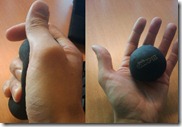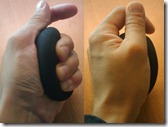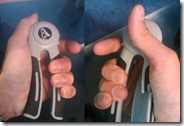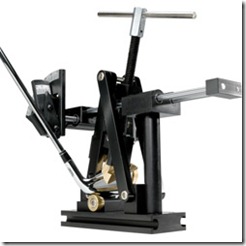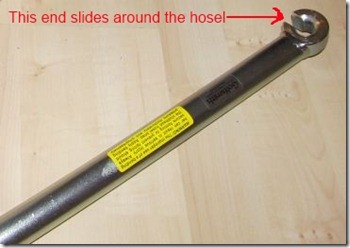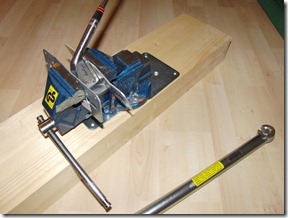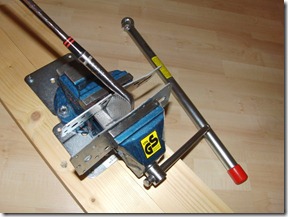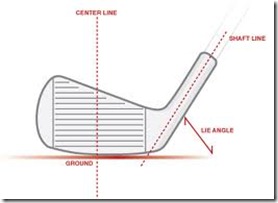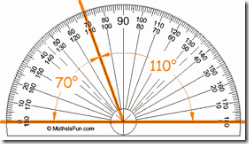The putter
Get yourself a simple blade style putter that let’s you know how well the ball has been struck. During training it’s very important to know what you are doing wrong. Say for instance that you don’t strike the ball with the center of the club. With some of the perimeter weighted putters this is very hard to feel. In my opinion, a good putter will give your hands the necessary feedback and will teach you the feeling and sound of a solid strike. Such a putter will make it easier to ingrain good habits. A simple ‘blade’ style design with less visual clutter allows for more precise aim IMO. I also prefer a putter that has enough weight to let you feel the clubhead during the stroke. With a heavier clubhead it’s also easier to start the backswing with a smooth, steady motion. If you go too heavy, you may find it hard to judge distance.
Setup
There lots of different ways of setting up to the ball. In the end it’s about finding a setup that allows you to rock your shoulders up and down square to where you want the ball to start.
For me that means that I basically stand square, or maybe slightly open to the target. If I grip the putter I feel that my shoulder line is slightly open (and the putter’s face is closed). From there I just square up my shoulders until the face of the putter is square to the target. I take a few practice strokes to check and groove this ‘dynamic’ alignment and if it’s good I take a small step forward and pull the trigger.
As far as your head is concerned, try to keep your chin against your chest. The more vertical your eyes can look down at the ball the better you will be able to see your line. Also, if you set up this way you can turn your head and trace the line to the hole with your eyes better.
I usually set up with an equal amount of weight on both my two feet but it may help to get some more weight on your front foot.
Grip
I use the a ‘standard’ putting grip with the right hand down. Most of the grip pressure is in my right hand, between thumb and index finger. My left hand, on the other hand, I wrap around the top end of the grip and my right hand
very lightly, where it can function as a stabilizer.
Ball Position
Just slightly forward of low point is where I prefer the ball to be. It depends on your stance width but this will either be at the center or forward of the center between your feet. It also depends on the loft of the putter but the main purpose is to get the ball rolling as soon as possible after the strike. If you hit the ball after low point (on the upstroke) the ball will get some topspin, which is what gets the ball rolling faster. The ball needs to be struck at the top half to eliminate skidding.
Distance From the Ball
I try to get my eyes directly above (or slightly inside) the ball and let that dictate the way I stand to the ball. Besides that, you may need to have the lie of the putter changed so you can stand more comfortably. It’s important that the sole of the club is flush to the ground.
Anchor Points
Before (and during the stroke) I make sure that my left hip and my throat remain in a fixed position. I need to feel some stability in my legs/knees too. Practice this until it becomes second nature. This will give you a stable base upon which to swing the putter.
Starting the Stroke
I start the stroke by simultaneously dropping my left shoulder and taking the club away with my right hand. Ideally the shoulders and arms should move as one unit, with the shoulders moving in a vertical, up-and-down manner. During the stroke I keep my eyes focused on a small spot of the back of the ball. Sometimes it helps to stare at the ball
without focusing on it. What you don’t want to do is follow the clubhead on it’s way back. I know this can be very tempting but it will only make for a wobbly takeaway.. Try to take the club away with a steadily accelerating tempo, gradually adding grip pressure.
A Change of Direction
The change of direction in the putting stroke is very important if you want to get any good at distance control. It should be almost effortless in the sense that the intensity and length of the backswing determines the timing and length of the downswing. It should be a natural reaction to the backswing without any interference from the hands and arms. The only thing to monitor is that the left shoulder moves upward during the downstroke.
Once you get this you will start to hit more putts with perfect speed and see lots of balls dying in the hole. It can be tricky to kill the hit instinct, even with putting, but the results are worth it. It may seem like you are giving up control of your downswing but in reality you’ll get way more control once you start seeing the true relation between backswing and downswing. The backswing being the action, the downswing being the reaction to that action. The added benefit is that your stroke will become purer because you won’t have to be steering the club on the downswing and contact will be better as well.
If you have trouble getting the hang of this you may find this helpful: Take a backswing, and pause the club at the the point where the change of direction takes place for just one second, and then let it all ‘fall’ towards the target. The momentum is set up by the intensity and length of the backswing and it can be stored by holding the club still before releasing it all on the downswing.


